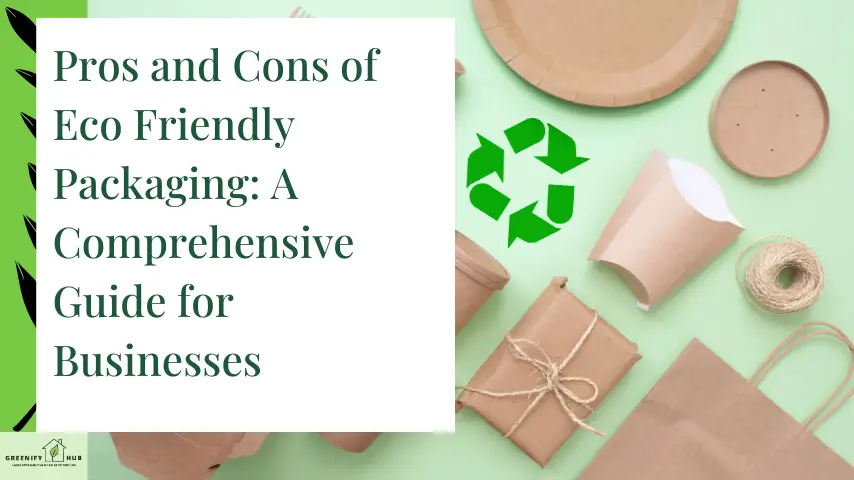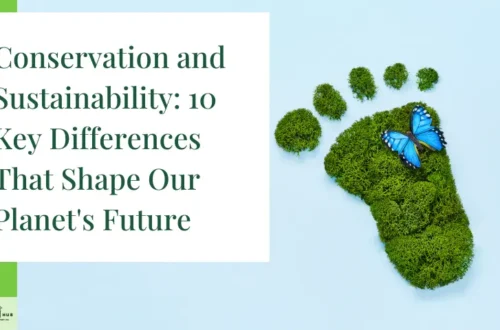Pros and Cons of Eco Friendly Packaging: A Comprehensive Guide for Businesses

In recent years, eco friendly packaging has taken center stage in the business world. Companies, big and small, are recognizing the urgent need to reduce their environmental impact.
Take Starbucks, for example. They’ve replaced their iconic plastic straws with sippy cup-style lids, saving millions of straws from landfills each year.
Or consider Amazon’s “Frustration-Free Packaging” initiative. It’s designed to be 100% recyclable and easy to open, reducing waste and improving customer experience.
These green packaging solutions aren’t just good for the planet. They’re also good for business.
Consumers are becoming increasingly eco-conscious. They’re actively seeking out brands that align with their values.
As a result, sustainable packaging is no longer just a nice-to-have. It’s becoming a must-have for businesses looking to stay competitive in today’s market.
The rise of eco-friendly packaging reflects a shift in both consumer expectations and business priorities, making it a crucial consideration for modern companies.
Understanding Eco Friendly Packaging
Eco-friendly packaging, also known as green packaging or sustainable packaging, is designed to minimize environmental impact. But what exactly does that mean?
Types of Eco-Friendly Packaging
Biodegradable Materials
These break down naturally over time. Think of those compostable takeout containers made from plant fibers.
Recyclable Packaging
This includes materials like cardboard, glass, and certain plastics that can be processed and reused.
Compostable Packaging
Similar to biodegradable, but these break down into nutrient-rich soil. Imagine throwing your empty chip bag into your garden compost!
Reusable Packaging
Think of refillable glass milk bottles or sturdy shopping bags designed for multiple uses.
The key is that these forms of packaging reduce waste, conserve resources, and lower carbon emissions throughout their lifecycle.
For instance, a company might switch from plastic bubble wrap to biodegradable air pillows made from corn starch. Or replace styrofoam peanuts with recyclable paper filling.
It’s not just about the end product, though. The entire production process matters too. Eco-friendly packaging often uses less energy to manufacture and transport.
Eco-friendly packaging encompasses a variety of materials and approaches, all aimed at reducing environmental impact throughout the product’s lifecycle.
RELATED: Understanding Eco Friendly and Environmentally Friendly
The Growing Demand for Sustainable Packaging
Today’s consumers are more environmentally conscious than ever before. They’re not just looking for great products; they’re seeking brands that share their values.
A recent study by Trivium Packaging found that 74% of consumers are willing to pay more for sustainable packaging. That’s a significant shift in consumer behavior!
This rise of conscious consumerism is driving businesses to rethink their packaging strategies. Companies like Lush Cosmetics have embraced this trend, selling many products with no packaging at all – their “naked” range.
Even giants like Coca-Cola are feeling the pressure. They’ve committed to making 100% of their packaging recyclable by 2025.
This growing demand isn’t just a fad. It’s a reflection of deepening environmental concerns among consumers. From climate change to plastic pollution, people are increasingly aware of the impact their purchases have on the planet.
The surge in demand for sustainable packaging reflects a broader shift in consumer values, pushing businesses to adopt more environmentally friendly practices.
RELATED: Environmental Sustainability Unveiled: Key Concepts Shaping Our Future
Pros of Eco-Friendly Packaging
Reduced Environmental Impact
One of the most significant advantages of eco-friendly packaging is its reduced environmental impact. Traditional plastic packaging can take hundreds of years to decompose, contributing to the growing problem of plastic waste.
Consider this: a plastic water bottle you use for a few minutes can stick around in the environment for up to 450 years!
Eco-friendly alternatives, on the other hand, can significantly reduce this impact:
– Biodegradable packaging breaks down naturally
– Recyclable materials can be reprocessed, reducing the need for new raw materials
– Compostable packaging turns into nutrient-rich soil
For example, Dell has replaced foam packaging with bamboo cushioning. This material is not only biodegradable but also grows quickly without pesticides.
Improved Brand Image and Customer Loyalty
Adopting eco-friendly packaging can do wonders for a brand’s image. It shows customers that a company cares about more than just profits.
Take Patagonia, for instance. Their commitment to sustainability, including their packaging choices, has earned them a fiercely loyal customer base.
This improved brand image can lead to:
– Increased customer loyalty
– Positive word-of-mouth marketing
– A broader customer base as environmentally conscious consumers switch to your brand
Regulatory Compliance and Risk Mitigation
As environmental concerns grow, so does regulation. Many regions, including the European Union and parts of the United States, are implementing stricter packaging laws.
By adopting eco-friendly packaging now, businesses can:
– Stay ahead of regulatory changes
– Avoid potential fines or penalties
– Demonstrate ethical business practices
For instance, the United Kingdom’s plastic packaging tax, introduced in 2022, charges manufacturers and importers for packaging with less than 30% recycled plastic.
Versatility and Reusability
Many forms of eco-friendly packaging offer versatility and reusability that traditional packaging lacks. This can add value for customers and reduce waste.
For example:
– Glass jars can be repurposed for storage
– Cardboard boxes can be easily recycled or composted
– Some innovative designs, like Puma’s “Clever Little Bag,” combine a reusable bag with recyclable cardboard
This versatility can enhance the customer experience and provide additional value beyond the primary product.
Eco-friendly packaging offers multiple benefits, from reducing environmental impact and improving brand image to ensuring regulatory compliance and providing added value through versatility and reusability.
Cons of Eco-Friendly Packaging
Higher Costs for Small Businesses
While eco-friendly packaging can lead to long-term savings, the initial cost of switching can be a significant hurdle, especially for small businesses.
For example:
– A small coffee shop might find that compostable cups cost twice as much as traditional plastic ones
– A local bakery could see packaging costs increase by 30% when switching to recyclable materials
These higher costs can be particularly challenging for businesses operating on tight margins. It might mean:
– Raising prices, potentially losing price-sensitive customers
– Absorbing the cost, which could impact profitability
– Delaying other investments or improvements
Production and Performance Challenges
Eco-friendly packaging, particularly those made from biodegradable materials, can present production and performance challenges:
– Some materials may not be as durable as traditional options
– Certain eco-friendly packaging may not be suitable for all product types
– Production processes can be more time-consuming or complex
For instance, a company producing perishable foods might find that biodegradable packaging doesn’t provide the same shelf life as plastic alternatives.
Potential Greenwashing Risks
As the green packaging movement gains momentum, there’s a risk of greenwashing – making misleading claims about environmental benefits.
This can lead to:
– Consumer skepticism and loss of trust
– Legal issues if claims are found to be false or misleading
– Damage to brand reputation
For example, a company might label its packaging as “eco-friendly” because it’s made from plants, even if the production process is highly energy-intensive and polluting.
These risks highlight the importance of transparency and thorough research in the decision-making process when adopting eco-friendly packaging.
While eco-friendly packaging offers numerous benefits, businesses must navigate challenges such as higher costs, performance issues, and the risk of greenwashing to successfully implement sustainable packaging strategies.
Eco-Friendly Packaging Materials and Innovations
The world of eco-friendly packaging is constantly evolving, with new materials and innovations emerging regularly. Here are some exciting developments:
Plant-Based Plastics
Made from renewable resources like corn or sugarcane, these materials look and feel like traditional plastic but are biodegradable.
Example: Coca-Cola’s “PlantBottle” is partially made from plant materials.
Mushroom Packaging
Believe it or not, mushroom roots (mycelium) can be grown into custom shapes, creating sturdy, biodegradable packaging.
Example: IKEA is exploring mushroom-based packaging to replace styrofoam.
Seaweed Packaging
Edible and biodegradable, seaweed-based packaging is being used for everything from condiment sachets to water bottles.
Example: Notpla creates seaweed-based packaging for beverages and sauces.
Recycled Ocean Plastic
Some companies are turning ocean plastic waste into new packaging materials.
Example: Procter & Gamble uses recycled beach plastic in some Head & Shoulders shampoo bottles.
Eco-Friendly Packaging Boxes
Innovative designs are making cardboard boxes more sustainable and functional.
Example: Amazon’s “Frustration-Free Packaging” reduces waste and improves the unboxing experience.
These innovations show that with creativity and technology, we can create packaging that’s both effective and environmentally friendly.
From plant-based plastics to mushroom packaging, innovative eco-friendly materials are revolutionizing the packaging industry, offering sustainable alternatives to traditional options.
Impact on Business Success
The multifaceted role of sustainable packaging in today’s business landscape cannot be overstated. It’s not just about being green; it’s about smart business strategy.
Consider these impacts:
Brand Image Enhancement
Eco-friendly packaging sends a powerful message about a company’s values. It shows customers that the brand cares about more than just profits.
Example: Lush Cosmetics’ packaging-free products have become a core part of their brand identity, attracting environmentally conscious customers.
Customer Acquisition and Retention
Sustainable packaging can be a deciding factor for many consumers. It can attract new customers and keep existing ones loyal.
Example: Who Gives a Crap, a toilet paper company, uses recycled paper packaging. This approach has helped them build a dedicated customer base.
Cost Savings in the Long Run
While initial costs may be higher, sustainable packaging can lead to long-term savings through reduced material use and improved efficiency.
Example: Puma’s “Clever Little Bag” reduced paper consumption by 65% and saved 8,500 tons of paper annually.
Competitive Advantage
In a crowded market, sustainable packaging can set a brand apart from competitors.
Example: Boxed Water Is Better differentiates itself from plastic bottled water brands with its recyclable carton packaging.
Eco-friendly packaging can significantly impact business success by enhancing brand image, attracting and retaining customers, potentially reducing costs, and providing a competitive edge in the market.
Implementing Eco-Friendly Packaging Strategies
Transitioning to sustainable packaging practices doesn’t have to be an all-or-nothing endeavor. Here’s a step-by-step approach:
1. Assess Current Packaging
Start by evaluating your existing packaging. What materials are you using? How much waste is generated?
Example: A clothing retailer might realize they’re using excessive plastic in their shipping packages.
2. Research Alternatives
Look into eco-friendly options that suit your products and brand. Consider different types of packaging materials and designs.
Example: The clothing retailer might explore recycled paper mailers or compostable garment bags.
3. Start Small
Begin with small changes. This allows you to test the waters without a massive overhaul.
Example: The retailer could start by replacing plastic air pillows with recycled paper filling.
4. Educate Customers
Communicate your sustainability efforts to your customers. Explain the benefits and any changes they might notice.
Example: Include a note in packages explaining the new eco-friendly packaging and how to dispose of it properly.
5. Monitor and Adjust
Keep track of the impact of your changes. Are they effective? How are customers responding?
Example: The retailer might survey customers about their experience with the new packaging.
Remember, every small change counts in the long run!
Implementing eco-friendly packaging strategies is a gradual process that involves assessing current practices, researching alternatives, starting small, educating customers, and continuously monitoring and adjusting based on results.
Future Trends in Sustainable Packaging
The packaging industry is evolving rapidly, with sustainability at the forefront. Here are some emerging trends:
1. Smart packaging that extends product life
2. Edible packaging materials
3. Packaging-free stores and refill stations
4. Blockchain for tracking packaging lifecycle
5. AI-optimized packaging designs
The Boston Consulting Group predicts that sustainable packaging will be a $440 billion market by 2025. This growth is driven by consumer demand, regulatory pressure, and technological advancements.
As these trends develop, we can expect to see more innovative packaging releases across various industries. The future of packaging is not just green—it’s smart, efficient, and possibly even edible!
The future of sustainable packaging is characterized by innovative technologies and designs that prioritize both functionality and environmental impact.
Making the Transition: A Step-by-Step Guide
Transitioning to eco-friendly packaging doesn’t have to be overwhelming. Here’s a practical guide to get you started:
1. Set Clear Goals
Define what you want to achieve. Is it reducing plastic use? Improving recyclability?
Example: “Reduce plastic packaging by 50% within two years.”
2. Audit Your Current Packaging
Analyze your existing packaging. What materials are you using? How much waste is generated?
Example: A food company might find that 70% of their packaging is non-recyclable plastic.
3. Research Alternatives
Explore eco-friendly options that suit your products and brand.
Example: The food company could look into compostable containers or recyclable plastics.
4. Consider the Entire Lifecycle
Think beyond just the packaging material. Consider production, transportation, and disposal.
Example: A seemingly eco-friendly option might have a high carbon footprint in production.
5. Start with Small Changes
Begin with easy-to-implement changes. These small steps can lead to significant impact over time.
Example: Switching from plastic bubble wrap to paper-based alternatives.
6. Educate Your Team and Customers
Ensure your team understands the changes. Communicate your efforts to customers.
Example: Train staff on new packaging protocols and add information about recycling on your website.
Remember, every step towards sustainability counts!
Transitioning to eco-friendly packaging involves setting clear goals, auditing current practices, researching alternatives, considering lifecycle impacts, starting with small changes, and educating stakeholders throughout the process.
Measuring the Impact of Eco Friendly Packaging
To truly understand the positive impact of your eco-friendly packaging initiatives, it’s crucial to measure and analyze key metrics:
1. Reduction in plastic use
2. Increase in recycling rates
3. Customer response rate to new packaging
4. Cost savings from reduced material use
5. Changes in brand perception
For example, a company might find that switching to recyclable packaging reduced their plastic waste by 30% and improved their customer satisfaction scores by 15%.
These metrics can provide astonishing statistics for today’s businesses. They not only demonstrate the environmental benefits but also showcase the business advantages of sustainable packaging.
Remember, what gets measured gets managed. Regular assessment ensures your eco-friendly packaging strategy continues to evolve and improve over time.
Measuring the impact of eco-friendly packaging through key metrics helps businesses quantify environmental benefits and business advantages, guiding future sustainability efforts.
Conclusion
As we’ve explored the multifaceted world of eco friendly packaging, it’s clear that the benefits often outweigh the challenges. From reducing environmental impact to enhancing brand image, sustainable packaging practices offer businesses a pathway to long-term success and customer loyalty. While obstacles like higher costs and production challenges exist, the growing demand from conscious consumers and regulatory bodies makes the transition increasingly necessary.
By embracing eco-friendly packaging, businesses can position themselves as leaders in sustainability, appealing to a broader customer base and potentially improving their bottom line. The key lies in thoughtful implementation, balancing cost considerations with environmental benefits, and staying informed about innovative materials and technologies.
As we look to the future, it’s evident that eco friendly packaging will play an increasingly vital role in business success. By taking small steps today, companies can make a significant positive impact on the environment while reaping the rewards of improved brand perception and customer loyalty. The journey towards sustainable packaging may be complex, but it’s undoubtedly a path worth exploring for businesses committed to a greener, more responsible future.
![Unlocking the Future: 6 Sustainable Energy Sources Revolutionizing Our World [Expert Guide]](https://greenifyhub.com/wp-content/uploads/2024/08/Unlocking-the-Future-6-Sustainable-Energy-Sources-Revolutionizing-Our-World-Expert-Guide-75x75.webp)



